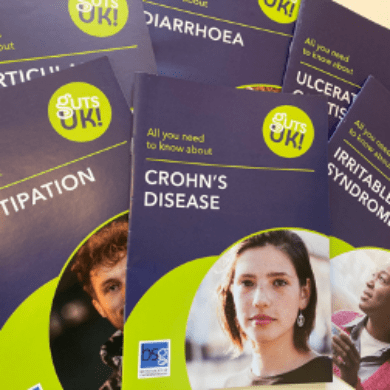Oesophageal Cancer
Download printable versionOverview
What is the oesophagus?
 The oesophagus (often known as the gullet) is a muscular tube that leads to the stomach. Food and drink pass from the back of the throat into the stomach through the oesophagus. When food is consumed the muscles at the top of the oesophagus contract, forcing food and fluid downwards into the stomach. At the lower end of the oesophagus there is a muscular valve (the sphincter), which prevents food and fluid being pushed upwards from the stomach.
The oesophagus (often known as the gullet) is a muscular tube that leads to the stomach. Food and drink pass from the back of the throat into the stomach through the oesophagus. When food is consumed the muscles at the top of the oesophagus contract, forcing food and fluid downwards into the stomach. At the lower end of the oesophagus there is a muscular valve (the sphincter), which prevents food and fluid being pushed upwards from the stomach.
Around 1 in 5, to 1 in 3 of the population appear to have a weakness of the lower oesophageal sphincter (valve), which allows acidic stomach contents to splash back up into the oesophagus, causing Heartburn and reflux (GORD).
Cancer of the oesophagus
Cancer of the oesophagus develops from the lining of the oesophagus, and has the effect of narrowing the oesophagus and causing difficulty in swallowing. At first solid food tends to lodge or stick in the oesophagus, and this is followed by difficulty in swallowing liquids.
The cancerous cells may spread outside the oesophagus to involve nearby structures, such as lymph nodes and blood vessels in the chest and abdomen. Cancer cells may also be carried in the blood stream to form secondary tumours (metastases), in the liver or elsewhere.
Most cancers in the upper two-thirds of the oesophagus are known as squamous carcinomas, because they develop from the squamous (skin-like) cells which line the oesophagus.
Cancers occurring in the area where the oesophagus joins the stomach are usually adenocarcinomas, derived from stomach-like cells. Adenocarcinoma often develops when the squamous cells at the lower end of the oesophagus have been replaced by stomach-type (columnar) cells, which have the potential to become cancerous. This condition is known as Barrett’s oesophagus1.
Oesophageal cancer is the 9th most common cancer worldwide3. The number of people diagnosed with oesophageal cancer in Northern Europe is approximately 5.5 people in 100,0001 of the population 7 out of 10 people diagnosed in Europe were male1,2.
Causes
Causes of oesophageal cancer
Squamous cell carcinoma (SCC)
Important risk factors for cancer of the oesophagus include smoking cigarettes and drinking alcohol, particularly spirits3. 7 in 20 oesophageal cancers are caused by smoking3. A combination of both smoking and spirit-drinking considerably increases the risk. The risk of this kind of cancer is also potentially increased for people who consume their drinks very hot. Infection with the HPV virus can occasionally cause SCC and there are other rare genetic causes4 such as ALDH2 deficiency alongside unhealthy alcohol intake increases the risk. The risk is also slightly increased if someone has a skin condition called Tylosis4. There is a rare disorder of the muscles of the oesophagus, known as achalasia6, in which there is a failure of relaxation of the muscular valve at the bottom of the gullet and contraction of the lower end of the oesophagus. This can very occasionally lead to cancer.
Areca (Betel) nut consumption, used in paan by some ethnic communities, has also been implicated with a younger age of oesophageal cancer onset and poorer response to therapy7.
This cancer is particularly common in some parts of Africa1 and China1, and is likely to be partly caused by the local diet or the way that food is preserved and cooked.
Adenocarcinoma
Cigarette smoking increases the risk of adenocarcinoma4. It also appears that the amount of acid reflux (see above regarding Barrett’s oesophagus) and the time over which the oesophagus has been exposed to this acid, are key risk factors4. This may explain the recent increase in the number of cases of adenocarcinoma of the oesophagus. 1 in 10 people with reflux (GORD) will develop Barrett’s Oesophagus. Of those with Barrett’s Oesophagus, 3 in 1000 people to 6 in 1000 people may develop oesophageal cancer per year which is a lifetime risk of 7.5-12.5% depending on several risk factors including how long Barrett’s has been present. A family history of oesophageal cancer can slightly increase the risk, 7 out of 100 of people diagnosed with Barrett’s oesophagus and cancer were related in a European study4.
Having an unhealthy body weight or having a body mass index (BMI) of 30 Kg/m2 or more is a cause in 1 in 4 oesophageal cancers. The higher the BMI the greater the risk, as this increases GORD and thus the risk of oesophageal adenocarcinoma.
Symptoms and diagnosis
What are the symptoms?
Oesophageal cancer may cause no symptoms until it begins to obstruct passage of food and fluids down the oesophagus, or to make swallowing painful. As the cancer develops, there is progressive difficulty in swallowing (dysphagia), at first with solids such as meat and bread, and then with softer foods. Eventually there is difficulty in getting liquids down. Patients begin to lose weight and may have other symptoms, such as choking, vomiting, coughing, unexplained chest infections or a hoarse voice. Although some patients report long-standing heartburn before developing these symptoms, most people who develop oesophageal cancer have no symptoms of this kind before they experience dysphagia.
How is the diagnosis made?
 Most patients seek medical attention because of problems swallowing. Going to the doctor early when symptoms begin is important, to increase the chances of early diagnosis and effective treatment. The GP is likely to make a referral to a specialist for investigations. These are likely to include a barium swallow. This involves swallowing a white liquid containing barium, which shows up on X-ray, outlining the oesophagus and revealing any obstruction. Another test likely to be used is an endoscopy, in which a narrow, flexible telescope is passed gently into the oesophagus through the mouth, using a local anaesthetic throat spray or sedation. Changes in the lining of the oesophagus can be seen and samples taken (biopsy) for laboratory examination.
Most patients seek medical attention because of problems swallowing. Going to the doctor early when symptoms begin is important, to increase the chances of early diagnosis and effective treatment. The GP is likely to make a referral to a specialist for investigations. These are likely to include a barium swallow. This involves swallowing a white liquid containing barium, which shows up on X-ray, outlining the oesophagus and revealing any obstruction. Another test likely to be used is an endoscopy, in which a narrow, flexible telescope is passed gently into the oesophagus through the mouth, using a local anaesthetic throat spray or sedation. Changes in the lining of the oesophagus can be seen and samples taken (biopsy) for laboratory examination.
Treatment
If cancer is diagnosed, other tests may be needed to see if it has spread. These include chest X-ray and ultrasound examinations of the chest, and other tests such as a CT scan, positron emission tomography (PET) scan.
A CT or MRI scan might be done to find out where the cancer is and if it has spread, these scans detect changes to body and organ structures. This is sometimes combined with another type of scan called a PET-CT scan, which detects microscopic changes in body cells by using a radioactive drug that shows where the cancer is more active inside the body. Sometimes an endoscope combined with an ultrasound at the end of the endoscope might be used to check areas inside the body from the oesophagus.
Occasionally it is necessary for a surgeon to look inside the abdomen using a special illuminated tube (laparoscopy) to look for other areas the cancer may have spread to.
Treatment:
- Endoscopic mucosal resection: this treatment is used when there are abnormal cells lining the oesophagus or the cancer is very small and found only on the surface of the oesophagus. This is similar to having an endoscopy, but the doctor will remove the abnormal cells during the procedure.
- Surgery: is the most common treatment in the United Kingdom, particularly if the cancer has not spread beyond the oesophagus.
The different types of surgery are as follows and will depend on the position of the tumour the surgeon may need to enter the chest cavity, the abdomen or the neck, and will remove the affected part of the oesophagus with the surrounding lymph glands.
- An oesophagectomy is when the part of the oesophagus containing the cancer is removed. The approach to this can vary from keyhole surgery to larger open skin incisions, depending on the location of cancer and the spread to adjacent lymph nodes. The principle of the surgery is to remove the cancer, along-with all adjacent lymph nodes and tissues that the cancer may have spread to give the patient the best chance of survival.
A tube is then made out of the stomach, which is drawn up into the chest or neck where it is joined to the remainder of the oesophagus. Patients are usually cared for in an intensive care ward after this operation.
The texture of the recommended diet may change initially whilst the surgical joins (anastomosis) made during the operation heals. Some people may need a short-term feeding tube into their bowel to help them maintain their weight, whilst they start to eat again, but a dietitian will provide help and support if this is the case.
After recovery most people are able to eat, although the size of meal may be reduced due to feeling full, and thus patients often eat less quantity but more frequently. Snacks in-between meals may be required and a dietitian can help you to maintain your weight.
Sometimes problems with swallowing can return weeks or months after the operation. This may be because the cancer has returned, but often is due to scarring (known as a ‘stricture’) where the surgeon has made the join (anastomosis). These strictures can be easily stretched using an endoscope. Sometimes more than one endoscopy might be required to resolve the stricture.
- Radiotherapy: uses high energy waves similar to x-rays to destroy cancer cells. Radiotherapy offers a potential cure, and it is particularly useful for people with early tumours, especially squamous cancer. Radiotherapy can be used in conjunction with chemotherapy and surgery and is also sometimes used as an alternative to surgical treatment, when the type and position of the tumour and the patient’s general condition may influence the decision to operate. When radiotherapy is given in an attempt to cure the cancer, it is known as radical radiotherapy. Or, when the tumour cannot safely be removed by surgery, radiotherapy, is used in smaller doses and is known is palliative radiotherapy, intended to treat the symptoms caused by the cancer. Palliative radiotherapy is sometimes used with chemotherapy to treat the symptoms. Radiotherapy can be given as an external beam or on the inside of the gullet via an endoscope (brachytherapy).
Chemotherapy: are drugs that are taken and work inside the body to destroy cancer cells (cytotoxic) they can be used at various stages of treatment. They can used alongside radiotherapy (chemoradiotherapy) or alone (chemotherapy). Either approach can reduce the size of the cancer making surgery easier and the chances of survival greater (neoadjuvant therapy). It can also be used alone if the cancer is small and this has the potential to cure the cancer, although you will be monitored closely after treatment. Chemoradiotherapy (chemotherapy and radiotherapy) also is advised if someone is not fit enough for surgery or the cancer has spread.
 Treatment of symptoms (Palliative care)
Treatment of symptoms (Palliative care)
If surgery is not possible, there are other ways to help to relieve difficulties in swallowing.
Endoscopic stent placement: is usually done under sedation or anaesthetic in the endoscopy department. A tube (called a stent) is inserted into the oesophagus to keep it open, so that food and fluid can be swallowed without difficulty. These tubes are made of either plastic or springy metal coils. They can become blocked by large food particles, so specific instructions on diet are always provided. Sometimes these tubes cause troublesome heartburn and regurgitation, which can be helped considerably by taking acid suppressing medication. If you still have weight loss or struggle with eating, ask for a referral to a dietitian from your consultant or GP.
Endoscopic laser treatment: is also possible, and a specialist endoscopist will use a laser to destroy any tumour that is growing into the gullet. In some people laser treatment and intubation need to be combined.
Support
Often during treatment specialist nurses are able to be contacted for support.
 If you have been informed that the cancer is able to be treated but not cured (palliative), then palliative care doctors and other health care professionals are sometimes available and they can be really useful in advising with regards to improvement of symptoms.
If you have been informed that the cancer is able to be treated but not cured (palliative), then palliative care doctors and other health care professionals are sometimes available and they can be really useful in advising with regards to improvement of symptoms.
MacMillan have information and support around all aspects of cancer and they have a helpline and written information to support people who have been diagnosed and their families. Helpline telephone: 0808 808 00 00 (seven days a week 8am to 8pm.)
The National Institute of Health and Care Excellence (NICE) provide guidelines that doctors can follow when diagnosing and treating people with oesophageal cancer and you can read what they recommend.
For people with cancer in the area between the gullet and the stomach there is an audit that is completed and if you want to take part you can find more information here For Public – National Oesophago-Gastric Cancer Audit (nogca.org.uk). The latest report can be found here 2021 Report for Public and Patients – National Oesophago-Gastric Cancer Audit (nogca.org.uk).
What to ask my doctor?
- What treatment is best for me?
- Are there any specialist nurses that can help guide me through the diagnosis and treatment?
- Would I be able to be referred to a palliative care team if my cancer is not able to be cured?
- Can I be referred to a dietitian for advice?
- Does the hospital have a prehabiliation scheme? (these schemes can improve fitness before surgery).
Prevention of oesophageal cancer
Patients with Barrett’s oesophagus are at increased risk of developing adenocarcinoma of the oesophagus. To try to prevent cancer developing, these patients are required to undergo endoscopic surveillance – inspection of the oesophagus through an endoscope in an attempt to pick up pre-cancerous changes, known dysplasia, and prevent progression to cancer. A number of trials of endoscopic surveillance in Barrett’s oesophagus are still underway, and it is not known for certain how effective different patterns of surveillance are like to be.
Guts UK is proud to fund oesophageal cancer research that will explore the use of breath-testing for pre-cancerous cell changes in patients with Barrett’s oesophagus. If successful, this research could diagnose people with oesophageal cancer earlier. Guts UK’s research saves lives. Join us, as we get to grips with guts.
 About us:
About us:
Guts UK’s vision is of a world where digestive diseases are better understood, better treated and where everyone who lives with one gets the support they need. We fund life-saving research into diseases of the gut, liver and pancreas.
Champion our cause; help us fight digestive diseases and change the lives of millions of people in the UK by supporting our work today.
References
- Cummings, D.; Wong, J.; Palm, R.; Hoffe, S.; Almhanna, K.; Vignesh, S. Epidemiology, Diagnosis, Staging and Multimodal Therapy of Esophageal and Gastric Tumors. Cancers 2021, 13, 582. https:// doi.org/10.3390/cancers13030582
- Sung H, Ferlay J, Siegel RL, Laversanne M, Soerjomataram I, Jemal A, Bray F. Global cancer statistics 2020: GLOBOCAN estimates of incidence and mortality worldwide for 36 cancers in 185 countries. CA Cancer J Clin. 2021 Feb 4. doi: 10.3322/caac.21660. Epub ahead of print. PMID: 33538338.
- Ferlay J, Colombet M, Soerjomataram I, Mathers C, Parkin DM, Piñeros M, Znaor A, Bray F (2019). Estimating the global cancer incidence and mortality in 2018: GLOBOCAN sources and methods. Int J Cancer. 144(8):1941–1953. https://doi.org/10.1002/ijc.31937 PMID:30350310
- Correa, P.; Piazuelo, M.B.; Wilson, K.T. Pathology of Gastric Intestinal Metaplasia: Clinical Implications. Am. J. Gastroenterol. 2010, 105, 493–498.
- Watanabe M. Risk factors and molecular mechanisms of esophageal cancer: differences between the histologic subtypes. J Cancer Metastasis Treat2015;1:1-7. http://dx.doi.org/10.4103/2394-4722.153534
- Harvey PR, Thomas T, Chandan JS, Mytton J, Coupland B, Bhala N, Evison F, Patel P, Nirantharakumar K, Trudgill NJ. Incidence, morbidity and mortality of patients with achalasia in England: findings from a study of nationwide hospital and primary care data. Gut. 2019 May;68(5):790-795. doi: 10.1136/gutjnl-2018-316089. Epub 2018 Jun 20. PMID: 29925629.
- Chen CH, Lu HI, Wang YM, Chen YH, Lo CM, Huang WT, Li SH. Areca nut is associated with younger age of diagnosis, poor chemoradiotherapy response, and shorter overall survival in esophageal squamous cell carcinoma. PLoS One. 2017 Feb 28;12(2):e0172752. doi: 10.1371/journal.pone.0172752. PMID: 28245263; PMCID: PMC5330470.
- Hvid-Jensen F, Pedersen L, Drewes AM, Sørensen HT, Funch-Jensen P. Incidence of adenocarcinoma among patients with Barrett’s esophagus. N Engl J Med. 2011 Oct 13;365(15):1375-83. doi: 10.1056/NEJMoa1103042. PMID: 21995385.
- Picardo SL, O’Brien MP, Feighery R, O’Toole D, Ravi N, O’Farrell NJ, O’Sullivan JN, Reynolds JV. A Barrett’s esophagus registry of over 1000 patients from a specialist center highlights greater risk of progression than population-based registries and high risk of low grade dysplasia. Dis Esophagus. 2015 Feb-Mar;28(2):121-6. doi: 10.1111/dote.12166. Epub 2014 Jan 15. PMID: 24428806.





